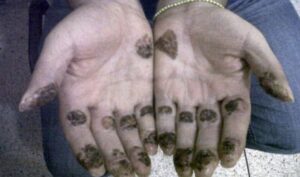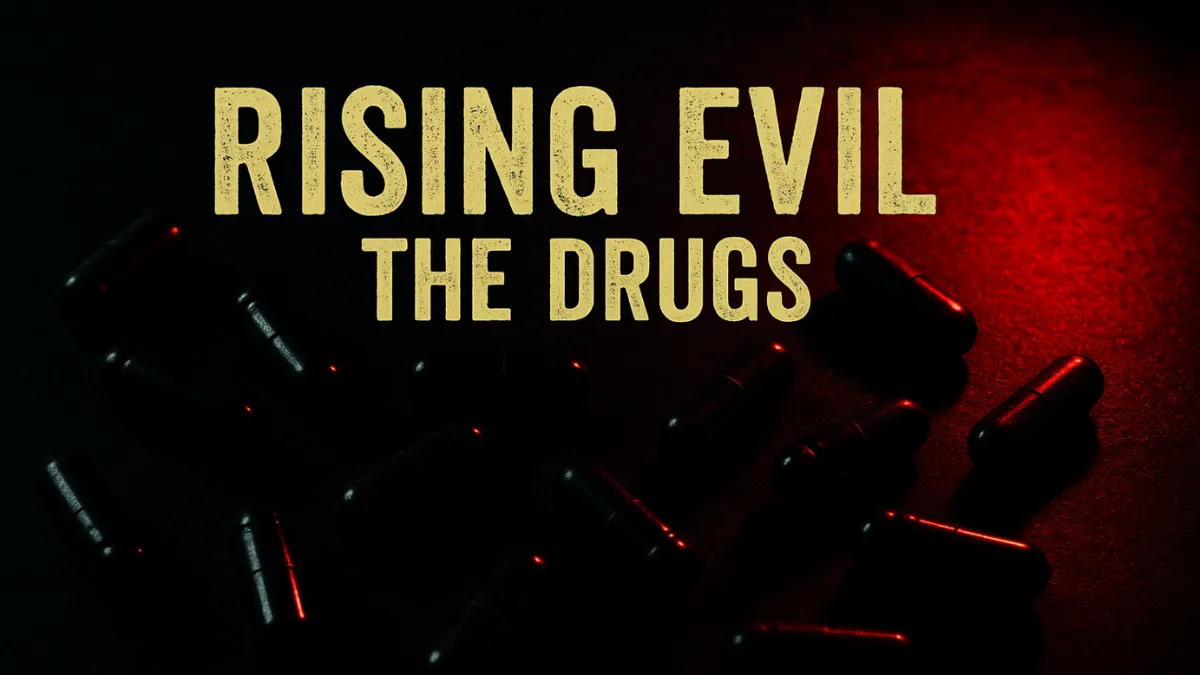Last Updated on November 24, 2021 by Nyayik Vigyan
Fingerprints have been successfully used for identification purposes for more than a century and remained one of the most commonly recovered evidence at the crime scene. Due to their uniqueness and individualistic characteristics, fingerprints are considered the most powerful and widely used biometric characteristic. The fingerprints of the toes are also unique and can be used for identification because no two individuals have been found to have similar fingerprints. The same also applies to the palms of the hands and the soles of the feet. Fingerprints appear in the intrauterine life, during the first trimester and completed in the second trimester, and it is widely believed that they do not change during the lifetime of an individual. But despite this, it’s difficult to capture them in older people due to the loss of skin elasticity and less pronounced finger ridges (Fig.1).

Fig. 1 Hand fingertips of an old woman
Before fingerprints were adopted as a recognition method, a bone measurement was performed by the Bertillon method, named after the French policeman Alphonse Bertillon. He claimed each person has different body proportions, thus body measurements and photographs were enough for individual identification. This method was used for three decades but it often failed.
The fingerprints we leave are composed of numerous substances that our skin secretes or which have absorbed by the environment. In the case of dirty or dry hands, it will be more difficult to take the fingerprints, on the contrary, it will be easier for sweaty hands. Fingerprints could be incredibly durable because they can persist for half a century but also extremely fragile because destroyed with a careless brush of the hand. For this reason, criminals and illegal immigrants try to damage, alter or remove their fingerprints by a deep cut, burning, applied acids, etc. (Fig.2) but the damaged skin can reproduce cells to form the fingerprints exactly as they were before unless the cut penetrates the dermis and even with permanent scarring, the new scar becomes a unique identity mark.

Fig. 2 Hands with fingertips burned by acid to try to hide fingerprints.
Anyway, there are cases of fingerprints disappearance by natural causes or their absence since birth. Three genetic diseases prevent fingerprints formation: Nargeli Franceschetti Jadassohn syndrome (Fig.3) and Dermatopathia Pigmentosa Reticularis (Fig.4), both because of keratin related gene mutations.
The third is the autosomal dominant Adermatoglyphia (Fig.5) because of a mutation in the skin gene SMACRAD 1 and often referred to as immigration delay disease.

Fig.3 Hands with Nargeli Franceschetti Jadassohn syndrome

Fig.4 Hands with Dermatopathia Pigmentosa Reticularis

Fig.5 Hands with Adermatoglyphia
Also, certain skin diseases can destroy the layer of the skin lead to the loss of fingerprints. These include dermatitis, primary hyperhidrosis, irritant contact dermatitis, atopic dermatitis, dyshidrotic eczema, scleroderma, psoriasis, and mechanical abrasion. Also, some drugs particularly used in cancer treatment (chemotherapy), such as capecitabine/Xeloda for breast or colon cancer prolonged use leads to Hand-Foot Syndrome and loss of fingerprints (Fig.6).

Fig.6 Capecitabine-induced fingerprint loss of the thumbs of a 57-year-old woman with breast cancer.
Moreover, some specific jobs such as bricklayers, massage therapists, dry-cleaning workers, and people who frequently wash dishes by hand can lose some of the details and even lead to that no pattern is evident. Secretaries, file clerks, typists, and piano players can suffer from the fading of fingerprints. People who work with chemicals like calcium oxide can also lose some details in their fingerprints.
What about the future? The microbiome could be the new fingerprint: the collective DNA of bacteria, fungi, and viruses that make up our intestinal bacterial flora is a huge archive of information on our health, environment, diet, and genetics, and it is unique. Forensic scientists are currently considering using the microbiome for identification: evidence based on microbial forensic techniques has already been allowed in some U.S. courts.
References
- Benno Hartung, Wolfgang Thiel, Stefanie Ritz-Timme, Dieter Häussinger, Andreas Erhardt, Hand-foot Syndrome Induced Changes of the Palmar Epidermal Ridge Configurations During and After Treatment With Capecitabine, 2020, Legal Medicine (Tokyo), 23;45:101710.
- Chavarri-Guerra Y, Soto-Perez-de-Celis E, Images in clinical medicine. Loss of fingerprints. The Nex England Journal of medicine, 2015, 372(16): e22.
- Donghyun Kim, Dongwon Yun, A Study on the Effect of Fingerprints in a Wet System, Scientific Reports-Nature, 2019, 9(1):16554.
- Janna Nousbeck, Bettina Burger, Dana Fuchs-Telem, Ofer Sarig, Peter Itin, Eli Sprecher, show all authors, A Mutation in a Skin-Specific Isoform of SMARCAD1 Causes Autosomal-Dominant Adermatoglyphia, The American Journal of Human Genetics, 2011 89(2):302-7.
- Javier A. Cavallasca, Julia L. Riera, Jorge L. Musuruana,, Loss of Fingerprints Due to Raynaud’s Phenomenon, Medicina Clinica Journal, 2019 Aug 2;153(3):127-128.
- Jian Zhao, Xia Zhang, Xiaonan Cui, Di Wang, Bin Zhang, Liying Ban, Loss of Fingerprints as a Side Effect of Capecitabine Therapy: Case Report and Literature Review, Oncology Research, 2020; 28(1):103-106.
- Josh Ellenbogen, Alison Langmead, Forms of Equivalence: Bertillonnage and the History of Information Management, Technology and Culture, 2020; 61(1):207-238.
- Lene Bay, Christopher James Barnes, Blaine Gabriel Fritz, Jonathan Thorsen, Marlene Elise Møller Restrup, Linett Rasmussen, Johan Kløvgaard Sørensen, Anne Brun Hesselvig, Anders Odgaard, Anders Johannes Hansen, Thomas Bjarnsholt, Universal Dermal Microbiome in Human Skin, mBio, 2020, 11(1):e02945-19.
- Tanuj Kanchan & Kewal Krishan, Loss of fingerprints: forensic implications, Egyptian Journal of Forensic Sciences, 2018, Article number: 19.
Author: Dr. Francesca Ventresca
 Dr. Francesca Ventresca is an Italian molecular biologist who graduated with honors and enrolled in the National Order of Biologists. Member of the UNIBIOFOR (Association Union of Italian Forensic Biologists). She is also a forensic geneticist with several years of experience in the forensic genetics lab of the Institute of Legal Medicine of Ancona Torretta (AN). Now She works at the Bio Forensics Research Center in Angri (SA) as a research collaborator.
Dr. Francesca Ventresca is an Italian molecular biologist who graduated with honors and enrolled in the National Order of Biologists. Member of the UNIBIOFOR (Association Union of Italian Forensic Biologists). She is also a forensic geneticist with several years of experience in the forensic genetics lab of the Institute of Legal Medicine of Ancona Torretta (AN). Now She works at the Bio Forensics Research Center in Angri (SA) as a research collaborator.









Leave a Reply